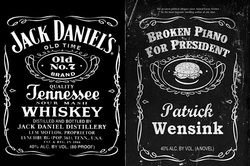 It can't be said enough. Everything you do, say, show, promote, post, provide, sell, tweet, create .... represents your brand. This is even more true in the era of the internet and viral media. Jack Daniels shows us how even communication from their legal department supports the brand and its promoters. See how the brand responded to an author who used the brand's signature label as inspiration for his book jacket. There are several articles out there covering the story, but here's a source we wouldn't normal cite: The Journal of the American Bar Association. How does legal represent your brand? As a follow-up to our previous post, Gatorade serves as an example of a well-conceived brand restage with results to prove it. We believe their approach works because - they knew what problem needed solving before the rebrand. There is no point to rebranding just for the sake of it. Clear objectives are a must. - they took a long, careful look at their core consumer (C1) and made the difficult decision to focus more specifically on the core's needs. - they respected the roots of the Gatorade brand and considered its role within the company (C2) - they understood that it was crucial to distinguish themselves from competitors (C3) in a truly meaningful way. In short, the Gatorade team kept its eye on all three Cs. Just as important, though, they walked the talk. Everything that the new brand stands for is evident in every part of the business - from the product line to where they advertise. Sound strategy is absolutely critical, but committed execution wins the game. Fast Company (required reading in our office) shares more of the background and particulars in its article, "How to Redefine a Flagging Brand." I just read about another company that has "re-branded" itself. As often happens, this so called "re-branding" amounts to little more than a redesigned logo and a refreshed web presence. Sorry, this is not actually a re-brand.
Let's start at the beginning. What is a brand anyway? At its most basic, a brand is the perception in the minds of its consumers and customers. That perception is driven by a myriad of elements - some which can be directly controlled by the brand owners and some that can't. A few elements that build up to a brand include:
Be forewarned, however, even a fully executed re-branding will not necessarily cure everything that ails a brand. The jury's still out on how well things will go for JCPenney. Your own brand is just a piece - albeit an important piece - of the puzzle. How your consumers/customers react and how your new brand compares to your competition are equally critical. Obvious advice from Hat Trick 3C. We know. It's disconcerting, but far too often two declarations are made about social media in the business world: 1) "Everyone/My Competitor/My Neighbors use social media so my company needs to do it, too." 2) "I'm running a business not trying to make friends. I don't see how social media makes any business sense." In both cases, I cringe.
Social media is a communication vehicle or a tool - just like billboards, bullhorns, hammers, or whisks. You don't decide you want to use a whisk and then run around trying to whisk things, results be damned. Rather, you start off with a task (in Hat Trick 3C parlance "an objective") and then pick the right tool for the job. The decision to use social media should go the same way: What are you trying to accomplish? Why? What does success look like? When you approach Twitter/Facebook/YouTube in this manner, you're more likely to be pleased with the results. Millward Brown, one of my all-time favorite market research agencies, recently posted a great POV about considerations around social media. You should check it out: http://www.millwardbrown.com/Libraries/MB_POV_Downloads/MillwardBrown_POV_Social_Media_Bubble.sflb.ashx - GLG The best relationships – with friends, family, and co-workers – are built on trust and great communication. As consumers, we look for brands that consistently provide these very same things.
This is exactly why I chose a particular camp for my daughter this summer. It was a brand I trusted from a previous experience with their preschool/daycare. They could always be counted on to communicate what was happening each week. They were great about sending home monthly calendars, weekly newsletters to hear about how lesson plans went, daily reminders about what to bring the next day, and even email reminders to reinforce messages. You may think this was over-communicating, but I really appreciated all that interaction with my hectic schedule. So the first week of summer rolls around and I haven’t heard from the camp. “Did I accidentally forget to register for the first week?” I asked myself. I felt certain I could trust them to send a welcome email before camp started. I called and sure enough I had registered and my daughter missed the first week of camp! Where was my reminder email? How was I supposed to know what my camper needed for the week? After several phone calls to understand where the breakdown was, they informed me that they have no systems in place to trigger welcome emails or reminders to parents. This would have been helpful information to know when I registered for camp. How can I trust them if they couldn’t even explain this when I registered and they offered no solution for the future? Wow, they are missing many opportunities to restore trust! Consumers also lost trust in Mattel in 2007 when they had to recall toys made in China not once, but twice because of lead paint. Mattel took quick action to regain the public’s trust. To start, the CEO publicly apologized and announced a new three-point check system. Next, Mattel didn’t hide behind the recalls. They used attention-grabbing ads on sites like Yahoo to alert customers and explain how to return the recalled products. Lastly, they have a Consumer Relations Support Center on their website to provide extensive details about recalls which reinforces transparency and helps rebuild trust. What do you do to maintain trust and communication with your customers? - Betsy P.S. Fisher Price announced a recall today via Facebook and provided customers with a link to their Customer Support Center tab on Facebook. What an excellent way to build and maintain trust through social media communication. And a customer has already given Kudos! Well done, Mattel. |
AuthorBetsy Kirkland, Hat Trick 3C's General Manager, loves branding and marketing so much that she sees opportunities for organizations to strengthen their brands everywhere she turns. AuthorGail Legaspi-Gaull is the founder of Hat Trick 3C. She lives and breathes marketing - sometimes to the consternation of her husband and kids. Archives
February 2013
Categories
All
|

|
|
 RSS Feed
RSS Feed
